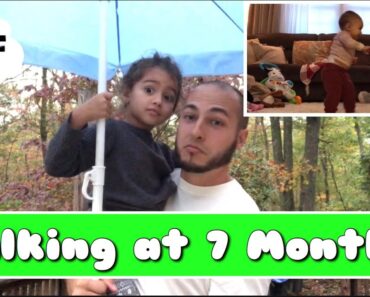image: iStock
Celiac disease is an autoimmune disorder where the person’s immune system displays abnormal sensitivity to the protein called gluten. The consumption of gluten-containing food items triggers an immune response, damaging the small intestine’s inner lining.
Gastrointestinal discomfort is the most discernible sign of the condition. Treatment mainly focuses on eliminating gluten from the baby’s diet. Read on to learn about the causes, symptoms, diagnosis, and treatment of celiac disease in toddlers and infants.
What Causes Celiac Disease In Babies?
Celiac or Coeliac disease occurs when the body’s immune system abnormally recognizes gluten as a pathogen (1). Gluten is a protein found in wheat, rye, and barley. It is a protein also found in food items prepared from these grains. Grains that naturally do not contain gluten, such as oats and millets, could be contaminated with gluten if processed at the same facility that processes wheat, rye, and barley.
The abnormal immune response occurs due to atypical genetic mutations in the group of genes called the human leukocyte antigen (HLA) complex (2). These genes help the immune system cells distinguish the body’s proteins from other proteins, such as those found in pathogens.
Abnormal HLA genes make the immune system cells sensitive to a segment of gluten called gliadin. When the cells detect gliadin in the small intestine, they consider it to be a pathogen. The immune system triggers an immune response similar to the one seen in pathogenic cases. It results in inflammation, damaging the inner lining of the small intestine and causing celiac disease.
Risk Factors For Celiac Disease In Babies
Since genes govern abnormal immune response in celiac disease, family history is usually considered to be the leading risk factor. Babies with parents or first-degree relatives with celiac disease may have a higher risk of developing the condition.
Infants and toddlers with the following conditions or disorders may also have a higher risk of developing celiac disease (3).
• Type 1 diabetes
• Selective immunoglobulin A deficiency
• Autoimmune thyroiditis
• Turner syndrome
• Williams syndrome
• Down syndrome
Not all babies with abnormal genes or risk factors may develop celiac disease. It is not known why some babies develop the condition. Environmental factors and the expressions of other genes may play a role in such cases (2).
Do Breastfed Babies Develop Celiac Disease?
Breastfeeding is not a risk factor for celiac disease since breast milk does not contain gluten. Therefore, exclusively breastfed babies do not develop the condition. The mother need not eliminate gluten from her diet since the quantity transferred to the breast milk is insufficient to trigger an immune response in the baby’s body (4).
Signs And Symptoms Of Celiac Disease
The signs and symptoms of celiac disease emerge once the baby starts consuming solids, which is between the ages of four and six months. Most babies display gastrointestinal symptoms. These may vary depending on the intensity of their immune response and the quantity of gluten consumed.
Infants and toddlers with celiac disease may display the following symptoms after ingestion of gluten-containing foods (5).
- Abdominal bloating
- Vomiting
- Foul-odored diarrhea
- Fussiness and irritability
The repeated immune response to the gluten damages the villi found along the small intestine’s inner lining. The villi are finger-like projections that absorb nutrients from food. Immune response to gluten erodes and flattens the villi, making it difficult for the small intestine to absorb nutrients. It may gradually lead to the following symptoms.
- Malnutrition
- Iron deficiency anemia
- Low bone density
- Poor growth and short stature
- Chronic fatigue
- Poor weight gain or chronic weight loss
- Developmental delay
- Neurological problems
How Is Celiac Disease Diagnosed?
The diagnosis of celiac disease in babies is a multi-step procedure due to similarities of its symptoms with those of other gastrointestinal conditions. The pediatrician will assess the symptoms and perform various tests to rule out the possibilities of infections, allergies, food sensitivities, food intolerances, and other gastrointestinal disorders. Once other tests lead to no specific diagnosis, the doctor may consider celiac disease as one of the suspected causes for the symptoms (6).
Parents could be asked details of the baby’s medical history, diet, and the duration of the symptoms. The following tests could be suggested to check specifically for celiac disease (7) (8).
- Blood test: Two to three milliliters of blood is drawn, usually from the baby’s heel. A tTG test is performed to assess the presence of anti-tissue transglutaminase antibodies, which are a type of IgA antibody. Individuals with celiac disease have a high number of these antibodies in their bodies.
- Endoscopy with biopsy: An endoscopy is suggested if the tTG test suggests the possibility of celiac disease. The baby is sedated with anesthesia, and an endoscopic tube is used to visualize the small intestine walls. The endoscope would contain tools to collect a small sample of the intestinal tissue for biopsy.
The doctor will review the blood tests, the images of the intestinal walls, and the biopsy results to conclude the presence of celiac disease. It is essential you do not start a gluten-free diet for your baby before diagnosis since it may cause false-negative test results.
Treatment For Celiac Disease In Babies
There is no cure for celiac disease. The only way to avoid symptoms and discomfort is to avoid gluten in the diet. Below are some salient attributes of the management of celiac disease in babies (9).
- You will need to eliminate all types or varieties of wheat, rye, and barley from the baby’s diet. The baby cannot have products, such as cakes, biscuits, and pies, made from these grains.
- Gluten could be found in several medicines, processed foods, candies, toothpastes, skin products, and even paints found on some toys. You may check for the “gluten-free” label on such products. Several celiac disease support organizations provide guidebooks about products that may potentially contain gluten.
- The baby may have gluten-free grains, such as millets, oats, and rice. The baby could also have pseudograins, such as quinoa and buckwheat. Soy, tapioca, and corn flours could make appropriate alternatives, too.
- Gluten-free grains could be contaminated with gluten if processed at the same facility where wheat, rye, or barley is processed. Check for the words “gluten-free” on the packaging. You may also check for gluten-free products especially made for those with celiac disease.
- Your baby’s pediatrician may refer you to a dietician who can plan an appropriate gluten-free diet plan for your baby. A dietician may also guide you on ways to avoid gluten in the baby’s diet.
Babies and toddlers could find relief from symptoms once gluten is eliminated from the diet. Since the baby can eat other food items, nutritional deficiencies seldom occur. Non-responsive celiac disease is considered when the baby shows no improvement. However, it occurs when the baby has other gastrointestinal conditions, such as lactose intolerance, or receives a small amount of gluten from some source (10).
In rare cases, some individuals may have refractory celiac disease (RCD), which does not respond to a gluten-free diet even after a year. RCD is extremely rare in children (11). Its treatment usually involves multiple immunosuppressive therapies coupled with tube feeding or parenteral nutrition (intravenous nutrition) (12).
Can Celiac Disease In Babies Be Prevented?
There is no definitive way to prevent celiac disease. A few studies suggest that babies be introduced to gluten-containing food items after six months of age while continuing breastfeeding. The research theorizes that the antibodies found in breast milk could help modulate a baby’s immune response, preventing abnormal reactions towards gluten (13). However, celiac disease tends to be genetic, and even those with genetic predisposition do not necessarily develop the disease. Therefore, there is no conclusive method to prevent the autoimmune disorder (14) Nevertheless, there are benefits of breastfeeding, including immunological benefits for the baby. You may ensure you continue to breastfeed your baby while introducing solids for at least 12 months of baby’s age.
Celiac disease is an autoimmune disorder, which is triggered due to gluten ingestion. Babies with celiac disease may consume several other grains and food items for nourishment. The condition is not reversible, but lifetime avoidance of gluten could prevent the onset of symptoms and severe discomfort.


































